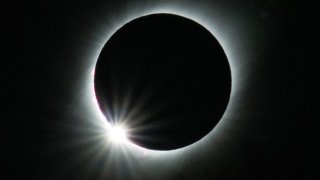
On Monday, April 8, North Texas will experience a total solar eclipse and NBC 5, Telemundo 39, the Fort Worth Public Library have compiled a wonderful list of books to encourage our young readers to learn as much as they can about this phenomenon.
A total solar eclipse occurs when the Earth, Moon, and Sun line up in space, completely blocking out the sunlight. The 2024 Total Solar Eclipse will be visible in North Texas. REMEMBER TO BE SAFE! It is not safe to look directly at the sun without specialized eyeglasses and protection. Viewing any part of the bright sun through a camera lens, telescope, or binoculars without authentic solar filtering glasses will instantly cause severe eye injury.
The book list below includes books on the total solar eclipse that can be borrowed for FREE in the Fort Worth Public Library Catalog. To apply for a free Fort Worth Public Library card, click HERE.
Any student currently attending pre-K through 12th grade at any formally recognized educational institution in North Texas may borrow Fort Worth Public Library books at no cost. Students do not have to be residents of Fort Worth to do so. They can get a Non-Resident Student library card from any Fort Worth Public Library location and the card provides them access to digital content as well as physical materials.
Get DFW local news, weather forecasts and entertainment stories to your inbox. Sign up for NBC DFW newsletters.
All of the books below can be accessed with this LINK.
FORT WORTH PUBLIC LIBRARY – Recommended Book List
Totality! An Eclipse Guide in Rhyme and Science
by Jeffrey O. Bennett
This book contains a short rhyme designed to help readers understand and remember what they'll experience when viewing an eclipse. Colorful illustrations and "Big Kid Boxes" with extended text connect the science and the rhyme.
Community
Connecting NBC 5 to the community we serve.
Sun! One in a Billion
by Stacy McAnulty
Series: Our universe.
"Meet Sun: He's a star! And not just any star--he's one in a billion. He lights up our solar system and makes life possible. With characteristic humor and charm, Stacy McAnulty channels the voice of Sun in this next celestial "autobiography." Rich with kid-friendly facts and beautifully illustrated, this is an equally charming and irresistible companion to Earth! My First 4.54 Billion Years
The Sun and the Moon
by Carolyn Cinami DeCristofano
Series: Let's-read-and-find-out science. Stage 1.
"The sun is out in the day and always has a circle shape. The moon’s shape seems to change and you can sometimes see it in the daytime and at night. What are the sun and the moon? How are they the same and how do they differ? Hop into your spaceship and find out
The Moon Seems to Change
by Franklyn M. Branley
Series: Let's-read-and-find-out science. Stage 2.
Explains the phases of the moon--the changes that seem to happen to it as it goes around Earth.
Eclipse Chaser: Science in the Moon's Shadow
by Ilima Loomis
Series: Scientists in the field.
"The August 2017 solar eclipse is the chance of a lifetime for astronomer Shadia Habbal--years of planning come down to one moment of totality. Will everything go off as planned
Stargazing for Kids: An Introduction to Astronomy
by Jonathan Poppele
Summary: Become a young astronomer. Learn about Hercules, Pegasus, and more. Best-selling author, educator, and naturalist Jonathan Poppele presents a kids' introduction to the joys of stargazing. Young readers will quickly gain confidence by discovering when to look, where to look, and what to look for.
Astronomy for Kids: How to Explore Outer Space with Binoculars, a Telescope, or Just Your Eyes!
by Bruce Betts
"One of the coolest things about outer space is that anyone can explore it. All you have to do is go outside and look up! In Astronomy for Kids, planetary scientist Bruce Betts helps you find and name the amazing objects in the night sky and shares fun facts about them. From stars and constellations to the planets and their moons, the northern hemisphere has plenty to see as long as you know what to look for and where to look
Moon! Earth's Best Friend
by Stacy McAnulty
Series: Our universe.
"A light-hearted nonfiction picture book about the formation and history of the moon and its history in relation to earth--told from the perspective of the moon itself
Wonders of the Night Sky: Astronomy Starts with Just Looking Up
by Raman Prinja
“For millennia, curious people have looked to the sky and wanted to understand the wonders that appeared. Readers can connect to the many parts of our universe visible to the naked eye and make inspiring connections to the science behind the stellar backdrop
What Happens During an Eclipse?
by Jennifer Lombardo
Series: Mysteries of Space
“Solar and lunar eclipses have been a source of fascination since ancient times. Early cultures created myths to explain what was happening, ranging from animals eating the celestial bodies to the sun leaving the sky in anger. Today, thanks to advancements in science, we understand the principles behind these astronomical events. However, this understanding has not diminished our awe and fascination. Through engaging, age-appropriate text, augmented by informative sidebars and detailed graphic organizers, this volume introduces readers to the science behind solar and lunar eclipses. Stunning full-color photographs also highlight the beauty of these natural phenomena.



